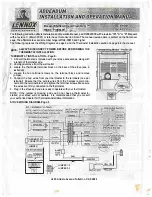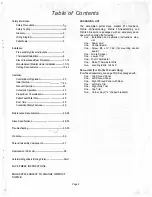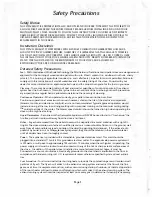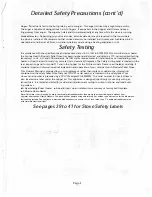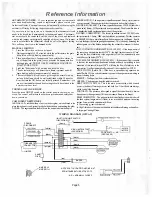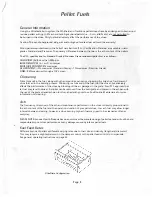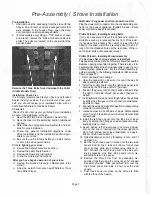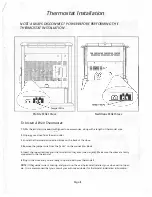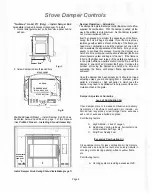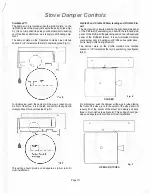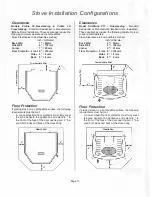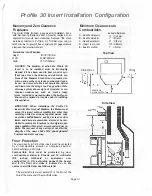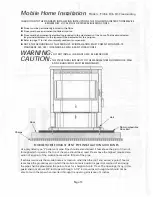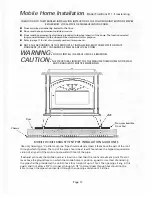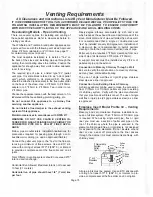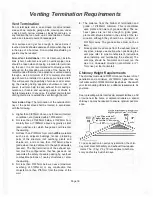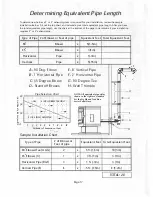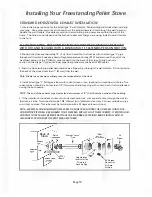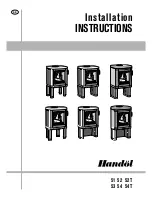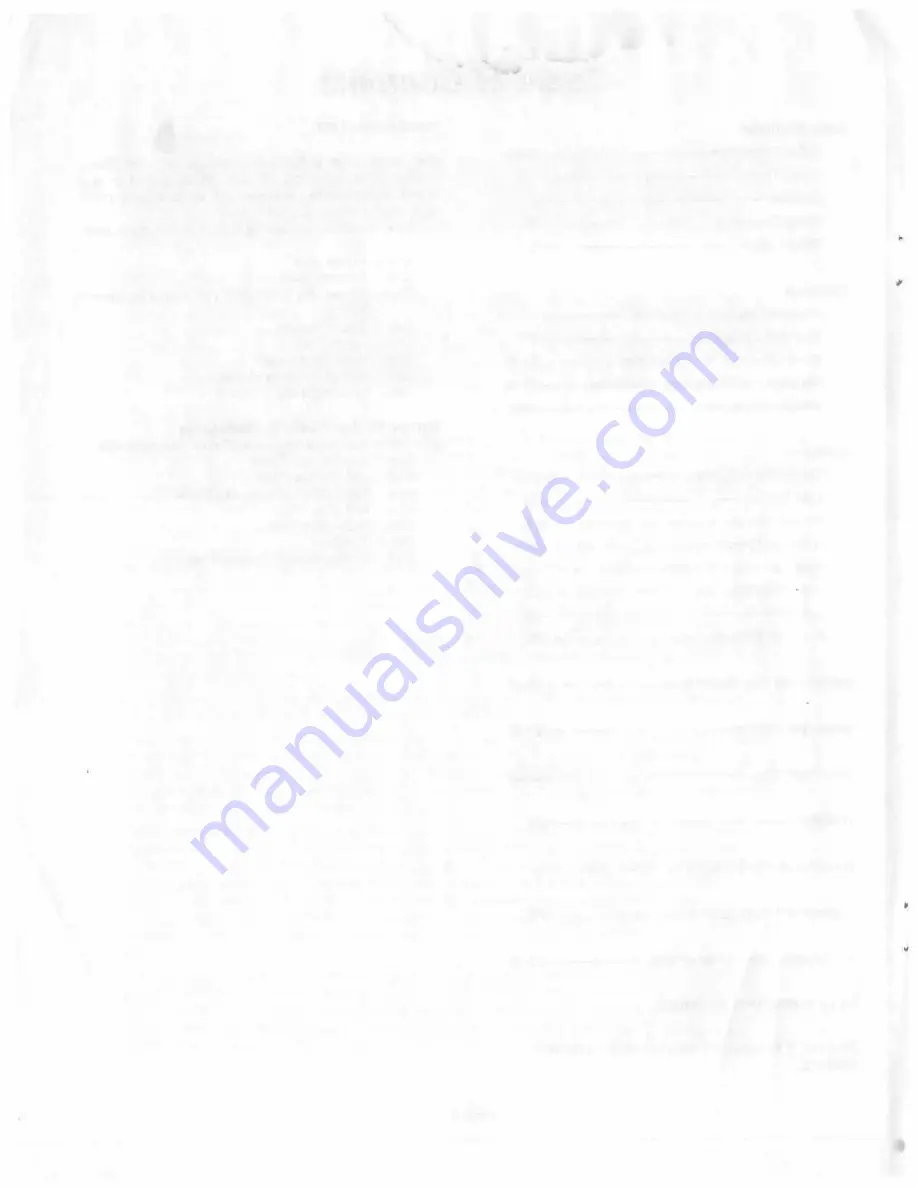
Safety Precautions
Safety Notice
THIS STOVE MUST BE PROPERLY INSTALLED AND OPERATED IN ORDER TO PREVENT THE POSSIBILITY OF
A HOUSE FIRE. PLEASE READ THIS ENTIRE OWNER'S MANUAL BEFORE INSTALLING AND USING YOUR
WHITFIELD PELLET STOVE. FAILURE TO FOLLOW THESE INSTRUCTIONS COULD RESULT IN PROPERTY
DAMAGE, BODILY INJURY OR EVEN DEATH. CONTACT YOUR LOCAL BUILDING OR FIRE OFFICIALS TO
OBTAIN A PERMIT AND INFORMATION ON ANY INSTALLATION RESTRICTIONS AND INSPECTION
REQUIREMENTS IN YOUR AREA.
Installation Disclaimer
THIS STOVES EXHAUST SYSTEM WORKS WITH NEGATIVE COMBUSTION CHAMBER PRESSURE AND A
SLIGHTLY POSITIVE CHIMNEY PRESSURE. THEREFORE, IT IS IMPERATIVE THAT THE EXHAUST SYSTEM BE
GAS TIGHT AND INSTALLED CORRECTLY. SINCE LENNOX HEARTH PRODUCTS, HAS NO CONTROL OVER
THE INSTALLATION OF YOUR STOVE, LENNOX HEARTH PRODUCTS GRANTS NO WARRANTY, IMPLIED OR
STATED FOR THE INSTALLATION OR MAINTENANCE OF YOUR STOVE, AND ASSUMES NO
RESPONSIBILITY FOR ANY CONSEQUENTIAL DAMAGE(S).
Detailed Safety Precautions
Fuel
- With its advanced UltraGrate technology, the Whitfield and Traditions brand pellet stoves are designed and
approved for the burning of wood residue pellets with up to 3% ash content (i.e. cardboard, nut hulls, cherry
pits etc.). The burning of agricultural residues (i.e. corn, alfalfa etc.) in pellet form is not permitted. Failure to
comply with this restriction will void all warranties and the safety listing of the stove. Consult with your
dealer for more information on approved pellet fuels and the proper burn grate for the fuels in your area.
Cleaning
- There may be some build-up of dust and smaller quantities of soot or creosote in the exhaust
system over the burn season. This will vary due to the ash content of the fuel being burned. A precaution-
ary inspection on a regular basis is advisable to determine the necessity of cleaning.
Continuous Operation
- When operated correctly, your pellet stove cannot be over-fired.
Continuous operation at a maximum burn can, however, shorten the life of the electrical components
(blowers, motors, and electronic controls), and is not recommended. Typical approved operation would
include running at the low to mid range setting with occasional running on the maximum setting during
the coldest periods of the winter. The blower speed control should be turned to high when operating the
stove on the high heat setting.
Liquid Flammables
- Gasoline or other flammable liquids must NEVER be used to start or "freshen-up" the
fire. Keep all such liquids well away from the stove at all times.
Ashes
- Any ashes· removed from the pellet stove must be deposited in a metal container with a tight-fit
ting lid. The closed container of ashei{should be placed on a noncombustible floor or on the ground, well
away from all combustible materials,. outside of the dwelling pending final disposal. If the ashes are dis
posed of by burial in soil or 6the�se locally dispersed, they should be retained in the closed container
until all cinders have been thoroughly cooled.
Power
- The appliance is provided with a detachable, grounded electrical cord. This cord should be
plugged into a standard, 115 volt, 60 Hz grounded electrical outlet. The approximate power requirement
is 200 watts, or will peak to approximately 700 watts for 15 minutes when the self-igniter is operating. The
power supply cord must be routed to avoid contact with any of the hot or sharp exterior surface areas of
the stove. In addition, if the pellet stove is installed in a manufactured (mobile) home, it must be:
Connected to a source of outside air, Electrically grounded to the steel chassis and Bolted to the floor in
compliance with and according to H.U.D. requirements unless otherwise specified by state or local authori
ties.
Soot Formation
- For all wood pellet fuel-burning heater products the combustion gases will contain small
particles of fly ash. The fly ash will collect in the exhaust venting system and restrict the flow of the flue
gases, over time. Incomplete combustion, such as occurs during startup, shutdown, or incorrect operation
of the room heater will lead to some soot formation which will collect in the exhaust venting system. The
exhaust venting system should be inspected at least once every year to determine if cleaning is necessary.
Page 3


